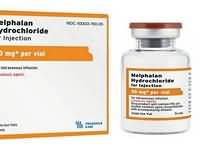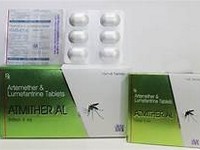Melphalan

CLINICAL USE
Alkylating agent:Myelomas Solid tumours Lymphomas Polycythaemia vera
DOSE IN NORMAL RENAL FUNCTION
Orally: 150–200 micrograms/kg daily Polycythaemia vera: 6–10 mg daily, reduced after 5–7 days to 2–4 mg daily, then further reduced to 2–6 mg per weekIV administration: 16–200 mg/m 2 according to indication and local protocol
PHARMACOKINETICS
Molecular weight :305.2 %Protein binding :60–90 %Excreted unchanged in urine : 11 Volume of distribution (L/kg) :0.5half-life – normal/ESRD (hrs) :0.5–2.5/4–6 DOSE IN RENAL IMPAIRMENT
GFR (mL/MIN)
20 to 50 : See ‘Other Information’ 10 to 20 : See ‘Other Information’ <10 : See ‘Other Information’ DOSE IN PATIENTS UNDERGOING RENAL REPLACEMENT THERAPIES
CAPD :Unknown dialysability. Dose as in GFR <10 mL/min HD :Not dialysed. Dose as in GFR <10 mL/min HDF/high flux :Unknown dialysability. Dose as in GFR <10 mL/min CAV/VVHD :Unknown dialysability. Dose as in GFR 10 to 20 mL/min IMPORTANT DRUG INTERACTIONS
Potentially hazardous interactions with other drugsAntipsychotics: avoid concomitant use with clozapine (increased risk of agranulocytosis)Ciclosporin: increased risk of nephrotoxicity ADMINISTRATION
Reconstition
10 mL of provided diluent Route
IV, oral Rate of Administration
Inject slowly into a fast running infusion solution or via an infusion bagComments
Further dilution with sodium chloride 0.9% OTHER INFORMATION
Melphalan clearance, though variable, is decreased in renal impairmentIncomplete and variable oral absorption – 25–89% post oral dose; AUC decreased by 39% when taken with foodSpontaneous degradation rather than enzymatic metabolism; Percentage of dose excreted in the urine as active or toxic moiety ranges from 11–93%; 20 to 50% excreted in the faeces within 6 daysCurrently available pharmacokinetic data do not justify an absolute recommendation on dosage reduction when administering melphalan tablets to patients with renal impairment, but it may be prudent to use a reduced dosage initially until tolerance is established When melphalan injection is used at conventional IV dosage (8–40 mg/m2 BSA) in patients with moderate to severe renal impairment, it is recommended that the initial dose should be reduced by 50% and subsequent dosage be determined by the degree of haematological suppressionFor high IV doses of melphalan (100– 240 mg/m2 BSA), the need for dose reduction depends upon the degree of renal impairment, whether autologous bone marrow stem cells are re-infused, and therapeutic need. High dose melphalan is not recommended in patients with more severe renal impairment (EDTA clearance less than 30 mL/minute)It should be borne in mind that dose reduction of melphalan in renal impairment is somewhat arbitrary. At moderate doses, where melphalan is used as part of a combined regimen, dosage reductions of up to 50% may be appropriate. However, at high doses, e.g. conditioning for bone marrow transplant, there is a risk of under-dosing the patient and not achieving the desired therapeutic effect, so the dose should be reduced with caution in these instancesAdequate hydration and forced diuresis may be necessary in patients with poor renal functionIn myeloma patients with renal damage, temporary but significant increases in blood urea levels have been observed during melphalan therapy.
See how to identify renal failure stages according to GFR calculation
See how to diagnose irreversible renal disease
Home









